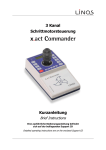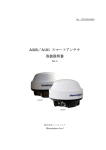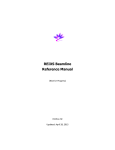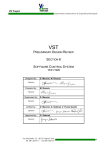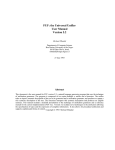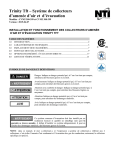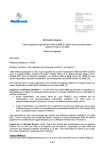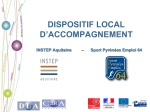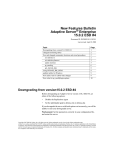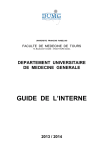Download Iram Document Template
Transcript
IRAM-PV02 Revision: 0 November 5, 2001 Contact Author Institut de RadioAstronomie Millimétrique Pico Veleta Antenna Mount Drive Control Owners Alain Perrigouard ([email protected]), Keywords: Approved by: A.Perrigouard Date: November 2003 Signature: IRAM NCS Antenna Mount Drive Control Change Record REVISION DATE AUTHOR SECTION/PAGE AFFECTED REMARKS Content 1 Hardware description.....................................................................................3 2 Software development...................................................................................3 2.1 Servo controllers........................................................................................3 2.1.1 Basic controller ..........................................................................3 2.1.2 Cascade controller.....................................................................4 Servo implementation................................................................................7 2.2.1 Kernel module int_ant................................................................7 2.2.2 Initialization tasks.......................................................................9 2.2.3 Slow and periodic tasks...........................................................10 Observation commands...........................................................................11 2.3.1 source ......................................................................................11 2.3.2 sourceOffsets...........................................................................12 2.3.3 setNextSubscanTrack .............................................................12 2.3.4 setNextSubscanSlewAzimuth..................................................12 2.3.5 setNextSubscanSlewElevation................................................13 2.3.6 setNextSubscanOtf..................................................................13 2.3.7 setNextSegmentLinear ............................................................13 2.3.8 setNextSegmentCircle .............................................................14 2.3.9 setNextSegmentCurve ............................................................14 2.3.10 prepareObservation .................................................................14 2.3.11 startObservation ......................................................................15 2.3.12 haltObservation........................................................................15 2.3.13 setPointingParameters ............................................................15 2.2 2.3 3 Some Results................................................................................................17 3.1 Tracking in cascade mode.......................................................................17 3.1.1 Azimuth step from 220deg to 220.2deg in cascade mode ......17 3.1.2 Elevation step from 45deg to 45.2deg in cascade mode ........18 Create Date:November 2001 NCSControl.doc Author: A.Perrigouard Page 2 of 19 IRAM 1 NCS Antenna Mount Drive Control Hardware description To drive the motor amplifiers and to read the encoders, a VME chassis replaces the old CAMAC interface in the 30m New Control System. Juan Penalver wrote already an extended document: 30M Antenna Control with VME Modules. To summarize, there is a Single Board Computer in slot 1, a Motorola MVME2041 plus a number of modules to interface the hardware: • BC366, a VMEbus Time code processor, used for generating different interrupts and to feed a NTP server. • IK320, a VMEbus counter card, used to read the Heidenhain ROD800 main axes encoders. • IK340, a VMEbus counter card, used to read the Heidenhain ROD456 motor encoders. 2 Software development 2.1 Servo controllers The implementation of the servo controllers is based on the work of Rainer Bardenheuer and his implementation made 18 years ago. Rainer’s controller software was executed on a CAMAC microprocessor board and was written in assembler. In the present implementation, the drives may be in different modes: PRESET, TRACK, INIT, STOP, etc. PRESET and INIT assume that the axes are driven in velocity. That means that the servomechanisms receive velocity requests. TRACK and STOP mean that the positions of the axes are the controlled variables. The servomechanisms may either receive velocity requests or torque requests. We call, servo controller, the part of this new software implementation that implements the servo algorithm and establishes the velocity or the torque requests. Two bits per axis in the “output register for elevation, azimuth and subreflector control” are used to switch from one mode of request to the other. In the following, the 2 cases are named basic and cascade. • • In basic, when the position is controlled in a closed feedback, the servo controller implemented in software is a PI controller. It is the case when the axis is in TRACK mode (variable request = TRACK) and the servomechanism is in basic (variable track = BASIC). Remark that the servomechanism is also in basic when the axis is in PRESET or INIT mode. In PRESET, The algorithm checks in a slow (loose) loop the position error, i.e. the difference between the target and the actual positions in order to reach the target at maximum speed/acceleration but without overshoot which would be generated inevitably with only a PI filter. In cascade, the servo loop always controls the drive position. The servo controller is a cascade of 2 PI controllers (position and velocity), the actual motor positions are feedback and there is a mechanism of friction compensation. In the following, the 2 controllers, basic and cascade, in their CAMAC and new VME implementations, are presented. The names of the variables are the names either used in the source codes or in the manual Antenna-ServoMechanism from R.Bardenheuer of November 20, 1985. 2.1.1 Basic controller In the manual “Antenna-servomechanism” page 4-2 the proportional gain is 3 in azimuth and 2.5 in elevation. The integration time is 5s. However, the same coefficients are used in the CAMAC implementation (K=3) for both axes. In the VME implementation we do the same choice, so, the same coefficients are used. Create Date:November 2001 NCSControl.doc Author: A.Perrigouard Page 3 of 19 IRAM NCS Antenna Mount Drive Control Figure 1 - Basic Controller - Camac implementation Ts is the loop period. Ts = 0.006s Σ is the sum or the integration of the input. KPMA = 3 * 2^15 / 36000 See KPMD in AZSERVO.LIS and ELSERVO.LIS KIA = Ts / T = 0.006 / 5 See KID in AZSERVO.LIS and ELSERVO.LIS Figure 2 - Basic Controller - VME implementation Ts is the loop period. Ts = 2^-7s Σ is the Sum or the integration of the input. Kp = 3 * 2^15 / 100 / 2^12 = 0.24 let’s define kp = 0.24 * 2^10 = 246 Ki = Kp * Ts / T = 0.24 * 2^-7 / 5 = 0.000375 lets define ki such that 2^-ki ~= 0.000375 => 2.1.2 ki = 11 Cascade controller In the manual “Antenna-servomechanism” page 4-2 there is representation of the cascade controller with the following definition of the variables: phiCom reference axis position in rad. phi actual axis position in rad. phiComDot reference axis velocity in rad/s. phiMotDot actual axis velocity in rad/s deduced from motor encoders and corrected of the gear ratio. To torque in mN applied to the antenna axis. integral is the normal time integral of the input. K = 2 s^-1 for Az and =2.5 s^-1 for El T = 0.24s for Az and = 0.2s for El KM = .9 10^9 mN s/rad for Az and = 1.5 10^9 mN s/rad for El TM = 0.18s for Az and = 0.12s for El Create Date:November 2001 NCSControl.doc Author: A.Perrigouard Page 4 of 19 IRAM NCS Antenna Mount Drive Control Figure 3 - Cascade controller - CAMAC implementation Ts is the loop period. Ts = 0.006s Σ is the Sum or the integration of the input. Azimuth: CASAK = K = 2 CASAT = Ts / T = 0.006 / 0.24s = 0.025 CASAKM = KM * RBGOFA RBGOFA = PI/180/36000 * 2^15/265 * 1/14165 .1"s->rad 1/DAC gain gear-ratio CASATM = Ts / TM = 0.006 / 0.18 = 0.03333 MVFCA = 6.35368867 Elevation: CASEK = K = 2.5 CASET = Ts / T = 0.006 / 0.2s = 0.03 CASEKM = KM * RBGOFE RBGOFE = PI/180/36000 * 2^15/265 * 1/15727 .1"s->rad 1/DAC gain gear-ratio CASETM = Ts / TM = 0.006 / 0.12 = 0.05 MVFCE = 5.72264259 Create Date:November 2001 NCSControl.doc Author: A.Perrigouard Page 5 of 19 IRAM NCS Antenna Mount Drive Control Figure 4 - Cascade controller – VME implementation Ts is the loop period. Ts = 2^-7s The axis encoder has a period of 36" and the VME module IK320 interpoles the period by a factor 2^12. 1 unit = 9 2^-10" and 1degree is equivalent to 100 2^12 encoder units. The motor encoder has a period of 720" (1800 periods/rev) and the VME module IK340 applies to the period a 256-fold interpolation. 1 unit = 360 * 3600 / 1800 / 256 " Azimuth: xkp = K = 2 let's define cXKp * 2^10 = xkp => cXKp = 2048 cXKp * xDelta overflows for abs(xDelta) > 2^31 / 2048 equivalent to xdelta > 2^31 / 2048 * 9 2^-10 = 9216" ~= 2.56deg OK xki = K * Ts / T = 2 * 2^-7 / 0.24 let's define 2^-cXKi = xki => cXKi = 4 vkp = .9 10^9 * PI/18000/2^12 * 2^15/265 * 1/14165 = .33477 KM 9 2^-10"->rad 1/DAC gain gear-ratio let's define cVKp * 2^10 = vkp => cVKp = 343 overflow for abs(cVelocity) > 2^31 / 343 equivalent to abs(cvelocity) > 2^31 / 343 * 9 2^-10 = 55027 "/s ~= 15.3deg/s OK vki = vkp * Ts / TM = .33477 * 2^-7 / 0.18 let's define 2^-cVKi = vki => cVKi = 6 m1Velocity = actual motor 1 position(IK340 unit) - previous motor 1 position m2Velocity = actual motor 2 position(IK340 unit) - previous motor 2 position vkv = 1/2 360*3600/1800/256 * 2^7 * 1/14165 * 2^10/9 = 1.4458 IK340 unit -> " 1/Ts gear-ratio "->9 2^10" unit let's define cVKv * 2^10 = vkv => cVKv = 1480 Overflow for abs(CVelocity) > 2^31 / 2^10 equivalent to abs(cvelocity) > 2^31 / 2^10 * 9 2^-10 = 18432"/s ~= 5.12deg/s OK Elevation: xkp = K = 2.5 let's define cXKp * 2^10 = xkp => cXKp = 2560 cXKp * xDelta overflows for abs(xDelta) > 2^31 / 2560 equivalent to xdelta > 2^31 / 2560 * 9 2^-10 = 7373" ~= 2.05deg OK Create Date:November 2001 NCSControl.doc Author: A.Perrigouard Page 6 of 19 IRAM NCS Antenna Mount Drive Control xki = K * Ts / T = 2.5 * 2^-7 / 0.2 let's define 2^-cXKi = xki => cXKi = 4 vkp = 1.5 10^9 * PI/18000/2^12 * 2^15/265 * 1/15727 = .50254 KM 9 2^-10"->rad 1/DAC gain gear-ratio let's define cVKp * 2^10 = vkp => cVKp = 515 overflow for abs(cVelocity) > 2^31 / 515 equivalent to abs(cvelocity) > 2^31 / 515 * 9 2^-10 = 36649 "/s ~= 10.2deg/s OK vki = vkp * Ts / TM = .50254 * 2^-7 / 0.12 let's define 2^-cVKi = vki => cVKi = 5 dMot1 = actual motor 1 position(IK340 unit) - previous motor 1 position vkv = 1/2 360*3600/1800/256 * 2^7 * 1/15727 * 2^10/9 = 1.3022 IK340 unit -> " 1/Ts gear-ratio "->9 2^10" unit let's define cVKv * 2^10 = vkv => cVKv = 1333 Overflow for abs(CVelocity) > 2^31 / 2^10 equivalent to abs(cvelocity) > 2^31 / 1333 * 9 2^-10 = 14159"/s ~= 3.93deg/s OK The implementation of the Cascade controller works perfectly in elevation with the above parameters scaled from the values found in the Rainer’s documentation and in ELSERVO.LIS. For the azimuth implementation the coefficients of the cascade position loop are slightly changed. The scaled coefficients does not give a stable controller when an azimuth step position is applied. The new proposed coefficients are a compromise between stability and low position error for tracking on a fixed position: cXKP=4096 and cXKi=6 2.2 Servo implementation Linux powers the Single Board Computer MVME2041. Fast and real time operations are executed in kernel modules. In those modules no floating number operations are allowed. The servo controller algorithms performed in the fast loop of a kernel module are only coded with integer numbers. As a consequence, all the operations should be verified carefully to avoid overflow or underflow. The implementation is triggered by 2 periodic interrupts at 128Hz and 1Hz. The period of the fast interrupt is ~7.8ms. It differs slightly from the 6ms period used in the Rainer’s implementation. This difference will not change the overall response of the servo and the power of 2 selected for the frequency of 128Hz simplifies greatly the coding. 2.2.1 Kernel module int_ant This module provides 3 functions (itFast(), itSlow() and encoder()) to handle 2 periodic interrupts generated by the bc366VME time code processor and the ik320 VME count card completion interrupts. The 2 periodic interrupts are the so-called heartbeat at 128Hz and the 1pps generated every second. We use the functions bc366_heartbeat_action() and bc366_pps_action() from the bc366 module to assign the handlers and the functions itFast() and itSlow() to these interrupts. The ik320 VME interrupts signals the end of the main axis encoder conversion. This interrupt, IRQ level 3, vector = 0xC1, is handled by this module by calling the function encoder(). 2.2.1.1 Heartbeat interrupt The function itFast() starts the main axes encoder position latching procedure and requests to the ik320VME module the generation of an interruption for the end of the conversion. It reads the 2 motor encoders for the axes, azimuth and elevation. Then, it calculates the motor differential positions and deduces the motor velocities in 9 2^-10”/s units. Create Date:November 2001 NCSControl.doc Author: A.Perrigouard Page 7 of 19 IRAM NCS Antenna Mount Drive Control The function has a conditional section compiled when the variable NOIK320 is defined: In a development situation when there is neither main axis encoder nor VME module ik320, the variables az.x0 and el.x0 are extrapolated here and the function move() is also called here(instead of being called after the reception of the ik320 interrupt driven by the conversion completion). 2.2.1.2 1pps interrupt The function itSlow() calculates for each axis, x0 and x1. x0 is the reference position for this current 1pps interrupt time and x1 is the reference position for the next 1pps interrupt time. dx is equal to the difference x1-x0 and sumDx is cleared. SumDx is used to accumulate dx every 7.8ms in encoder(). 2.2.1.3 ik320 interrupt The function encoder() reads the ik320 status register and depending on which axis is ready, reads the corresponding latched counters. If the condition variable SIMULATION is no defined, the variable xActual is calculated from the actual values of the latch counters and is saved in the shared memory area. If the drive is in remote, the variable xReference and vReference are updated: sumDx += dx xReference = x0 + dx vReference = dx If the variable MOVE_TEST is not defined (it’s the normal situation) the function move() is called. The variable MOVE_TEST has been defined once to allow the execution of the task moveTest and the debugging of the function move() which is called by moveTest. The function move() implements the servo code. It is called for each axis, as soon as the actual encoder position is read. The position error, px->xDelta, is calculated and depending on the variable px->request, different algorithms may be applied. px->xDelta is the difference between px->xReference and px->xActual. The variable px->request may have the possible values: R_PRESET, R_TRACK, R_SLEW, R_STOP or R_TRSFER. • R_TRSFER is foreseen for a session of collecting data and for calculating the drive transfer function. It is not tested with the 30m antenna. • R_PRESET is used to request the drive to reach a given position after a constant acceleration phase, a phase of displacement at maximum speed and then a constant deceleration phase. For a short distance, the phase at constant and maximum speed may not exist. This mode is always requested for a medium or long distance displacement to avoid tracking algorithm overshoot. When the absolute value of the axis velocity is under a certain threshold (px->xVelocityEpsil) and the absolute value of the position error is lower than px->xDeltaMin, the axis request mode is switched to R_TRACK. • R_TRACK is used to track a position. The servo mechanism is either in basic mode or in cascade mode depending on the variable px->track equal to BASIC or CASCADE. Note that whatever the value of px->track the BASIC servo mechanism is used when the axis px->request is R_PRESET. • R_STOP is used to keep the axis on a fixed position. When the axis px->request is set to R_STOP while it is moving, the axis is slow down and then is requested to track to the reached position by switching px->request to TRACK. Note that the DAC output will increase up to its maximum value if this mode is requested and the axis is locked for any reason (brake, amplifier switched off, etc…) • R_SLEW is used to move the axis in basic mode and at constant speed. The axes are in this mode at start time with a requested velocity px->vReference set to 0. This mode keeps the DAC output to 0 until the antenna is free to move. 2.2.1.4 Module installation Before installing this module, universe.o and bc336.o have to be installed and the encoder VME modules should be initialized. The installation procedure starts with the 2 kernel module installation: Create Date:November 2001 NCSControl.doc Author: A.Perrigouard Page 8 of 19 IRAM NCS Antenna Mount Drive Control modprobe universe modprobe bc336 We consider that the main axis encoder VME module ik320 has been already initialised and it is running. Another initialization of the VME module would cause a re-initialization of the incremental encoders. As a consequence, ik320Init is commented out in the procedure. The motor encoder VME module ik340 is initialized by calling ik340Init: #/control/antenna/bin/ik320Init /control/antenna/bin/ik340Init And finally: insmod /control/antenna/bin/int_ant 2.2.2 Initialization tasks The encoder VME module initialization tasks have to be executed before installing int_ant.o. If ik320Init is executed, the incremental encoders should be re-initialized and the axes should be turned enough to pass their init points and to reset the counters. ik340Init initializes the motor encoder VME module and can be executed at re-installation time. 2.2.2.1 ik320Init The task ik320Init is based on a source code written by Juan Penalver: ik320.c. The IK320 VMEbus Counter Card user’s manual and in particular the program example are necessary to understand this program executed to initialize the VME module. 2.2.2.2 Ik340Init The task ik340Init is based on a source code written by Juan Penalver: readenc.c. The IK340 VMEbus Counter Card user’s manual is necessary to understand this program executed to initialize the VME module. 2.2.2.3 initAntenna Once the kernel module int_ant.o is installed and the shared memory area described with the structure struct s_antenna is registered, the task initAntenna can initialize the elements of the shared memory area. The function antdata() returns the address of this area in the user space domain by calling mmap() . The function mmap() is one of the functions implemented in int_ant.o which is available for the device /dev/int_ant and in particular for its descriptor. The struct s_antenna describes the content of this shared memory area. The struct s_antenna is declared in s_antenna.h. This task sets the servo variables to their default values and switches the servo mechanisms, azimuth and elevation, to basic mode. 2.2.2.4 Config The task config is called just after initAntenna in the installation procedure but can be called at anytime later in order to modify some configuration variables. The values of the configuration variables are found in the file /control/antenna/config.30m. The format of each line of this file is: Variable_name value For instance: az.kp 246 Az proportional factor Create Date:November 2001 NCSControl.doc Author: A.Perrigouard Page 9 of 19 IRAM NCS Antenna Mount Drive Control If the first string does not correspond to any variable name, the line is considered as a comment line. All strings, following on the same line the configuration value, are considered as well as comments. The notation for the variable names is obvious. For the example, az is the element of type struct s_axes of the structure s_antenna and kp is one element of this struct s_axes. 2.2.2.5 InitObservation This task initializes the structures needed to define the sources and the subscans for the observations. This task should be executed before starting the slow periodic task evItSlow which prepares the position interpolations. The task calls the function shm_connect() to connect to the shared memory area identified by ‘PICO’. The struct s_observation describes the content of this shared memory area. The struct s_observation is declared in s_observation.h. The task sets to some default values, the elements of the structure slaInput of type struct s_slaParams. Those elements like longitude, latitude, temperature … are needed for calling the slalib functions. The task initializes also the roots and the chains of segments and subscans by setting all the variables firstSubscan, firstSegment, nextSubscan, nextSegment to –1. 2.2.3 Slow and periodic tasks These slow and periodic tasks are executed to prepare the reference positions and velocities. 2.2.3.1 SlaParams slaParams calculates, every 10s, the tables amprms[] and aoprms[] which are used in evItSlow() for the conversions between mean place and geocentric apparent place, and for the conversions between apparent to observed place. 2.2.3.2 EvItSlow evItSlow calls first antdata() to connect to the memory area shared with the kernel module int_ant.o. Next it opens the file descriptor fd to /dev/int_ant. This file descriptor is used later for the 1s synchronization. Note that this connection and this open are conditioned to the non-definition of the variable PCTCP00. If PCTCP00 is defined, antdata() executes only a connection to a shared memory area identified by ‘ANTE’ and defined with the same structure struct s_antenna. PCTP00 is defined only for debugging purpose. Next, evItSlow calls shm_connect() to get the pointer of the shared memory area identified by ‘PICO’. And finally, eItSlow implements a loop which is executed every second. If the variable PCTCP00 is not defined at compilation time, the loop is triggered by the call read(fd) which has for argument fd, the file descriptor to the device /dev/int_ant. This call synchronizes the execution of the loop to the occurrence of the 1pps interrupts. If the variable PCTCP00 is defined there is just a sleep(1) to simulate this 1pps synchronization. The variable PCTCP00 is used here for debugging purpose. In the loop, depending on the different observation modes, the commanded positions, az.command and el.command are calculated and finally are converted in encoder units (9 2^-10 arc-seconds) before being assigned to az.x2 and el.x2. The different observation modes are: IDLE, HORIZON, PREPARE, READY, RUN and STOP. Create Date:November 2001 NCSControl.doc Author: A.Perrigouard Page 10 of 19 IRAM NCS Antenna Mount Drive Control For the mode PREPARE, the function prepareScan() is called. If the time to prepare is passed, the scan starting position is evaluated and when this starting position is reached, the observation mode is switched to READY. For the mode READY, the function readyScan() is called. If a time to stop is defined and this time is passed, the observation mode is switched to STOP. Otherwise, if the time to start is passed, the observation mode is switched to RUN. For the mode RUN, the function runScan() is called. The function calculates the running positions depending on the type of the current subscan. If a time to stop is defined and this time is passed, the observation mode is switched to STOP. If there is no more subscan or they have not yet been defined, the observation mode is switched to READY. For the mode STOP, the function stopScan() is called. The function requests the axes to stop immediately and it clears the integration buffers of the cascade servos. 2.3 Observation commands These observation commands correspond to the signatures (number of arguments, type, meaning) listed in the document antennaMountDrive.h. This document edited by W.Brunswig, A.Sievers, H.Ungerechts and A.Perrigouard defines the interface between the coordination and synchronization tasks and the mount drive observation tasks and modules: 2.3.1 source * ABSTRACT : Define a new source. * * source <sourName> <basisSystem> <equinoxSystem> <equinoxYear> \* * <lambda> <beta> <descriptiveSystem> <alphaD> <betaD> <gammaD> \ * * <projection> <lambdaProjection> <betaProjection> < kappaProjection> * * All arguments are mandatory. * * sourceName name of the source or NULL * * basisSystem one number [0,6] among the basisSystemEnum * * 0 GALATIC, galactic * * 1 EQUATORIAL,mean equatorial * * 2 APPARENTEQUATORIAL, apparent equatorial * * 3 ECLIPTIC, mean ecliptic * * 4 APPARENTECLIPTIC, apparent ecliptic * * 5 HADEC, apparent hour angle and declination * * 6 HORIZONTAL * * equinoxSystem one number [0,1] among the equinoxSystemEnum * * 0 J, IAU 1976, FK5, Fricke system * * 1 B, Bessel-Newcomb, FK4 system * * equinoxYear year of the equinox * * lambda source longitude (radian) * * beta source latitude (radian) * * descriptiveSystem one number among the descriptiveSystemEnum * * 0 NODESCRIPTIVE, no descriptive system * * 1 ORIGIN, origin definition of descriptive sys.* * 2 POLAR, polar definition of descriptive system* * 3 EULER,Euler definition of descriptive system * * alphaD 1st angle for descriptive system (radian) * * betaD 2nd angle for descriptive system (radian) * * gammaD 3rd angle for descriptive system (radian) * * projection one number among the projectionEnum choice * * 0 NOPROJECTION, no projection * * 1 RADIO, "radio" convention with 1/cos(beta) * * 2 TAN, gnomonic * * 3 SIN, orthographic * * 4 STG, stereographic * * 5 ARC, zenithal equidistant * * 6 ZEA, zenithal equal area * Create Date:November 2001 NCSControl.doc Author: A.Perrigouard Page 11 of 19 IRAM * * * * * * * * NCS Antenna Mount Drive Control 7 CAR, cartesian / plate caree 8 MER, mercator 9 CEA, cylindrical equal area / Lambert 10 GLS, Sanson-Flansteed 11 AIT, Hammer-Aitoff lambdaProjection 1st angle for projection (radian) betaProjection 2nd angle for projection (radian) kappaProjection 3rd angle for projection (radian) * * * * * * * * !!! sourceName not archived 2.3.2 sourceOffsets * ABSTRACT : Define offsets to be applied to the next source (not the * current or active source). * sourceOffset <xOffset> <yOffset> <systemOffset> * The next source has to be already defined. * The 3 arguments are mandatory. * xOffset offset along x in radians * yOffset offset along y in radians * systemOffset one number [0,7] among the enum systemOffsetEnum * 0 PROJECTION * 1 DESCRIPTIVE, descriptive coordinates * 2 BASIS, basis system * 3 EQUATORIALOFF, mean equatorial J2000.0 * 4 HADECOFF, (apparent) hour angle and declination * 5 HORIZONTALTRUE, az with 1/cos(el) factor and el * 6 HORIZONTALOFF, azimuth and elevation * 7 NASMYTH * systemOffset can be PROJECTION if * source.projection != NOPROJECTION * systemOffset can be DESCRIPTIVE if * source.descriptiveSystem != NODESCRIPTIVE * PROJECTION, DESCRIPTIVE and BASIS are mutually execlusive and * the last accepted command with one of these systemOffsets * clears the other related offsets. * HORIZONTALTRUE and HORIZONTALOFF are mutually exclusive. 2.3.3 * * * * * * * * * * * * * * * * * * * * * * * * setNextSubscanTrack * ABSTRACT : Define a subscan track * setNextSubscanTrack <time> <traceFlag> <subscanId> * The 3 arguments are mandatory. * time duration of tracking in seconds (double) * traceFlag add flag to trace, a number [0,18] among the enum * traceFlagsEnum * subscanId subscan identifier (int) * A passive source should be already defined. In case no passive * source exists, an active source should exists. * * * * * * * * * !!! The duration is not a string !!! The subscanId is not a string 2.3.4 setNextSubscanSlewAzimuth * ABSTRACT : Define a subscan slew in azimuth. * setNextSubscanSlewAzimuth <azimuthStart> <azimuthEnd> * <elevation> <speed> <traceFlag> <subscanId> * The 6 arguments are mandatory. * azimuthStart azimuth start position in radians Create Date:November 2001 NCSControl.doc Author: A.Perrigouard Page 12 of 19 * * * * * IRAM * * * * * * * * NCS Antenna Mount Drive Control azimuthEnd elevation speed traceFlag azimuth end position in radians elevation in radians speed in radians/second add flag to trace, a number [0,18] among the enum traceFlagsEnum subscanId subscan identifier (int) A passive source should be already defined. In case no passive source exists, an active source should exists. * * * * * * * * !!! The subscanId is not a string 2.3.5 setNextSubscanSlewElevation * ABSTRACT : Define a subscan slew in elevation. * setNextSubscanSlewElevation <elevationStart> <elevationEnd> * <azimuth> <speed> <traceFlag> <subscanId> * The 6 arguments are mandatory. * elevationStart azimuth start position in radians * elevationEnd azimuth end position in radians * azimuth elevation in radians * speed speed in radians/second * traceFlag add flag to trace, a number [0,18] among the * enum traceFlagsEnum * subscanId subscan identifier (int) * A passive source should be already defined. In case no passive * source exists, an active source should exists. * * * * * * * * * * * * * !!! The subscanId is not a string 2.3.6 setNextSubscanOtf * ABSTRACT : Define a subscan On The Fly. * setNextSubscanOtf <systemOffset> <subscanId> * The 2 arguments are mandatory. * systemOffset one number [0,7] among the enum systemOffsetEnum * 0 PROJECTION * 1 DESCRIPTIVE, descriptive coordinates * 2 BASIS, basis system * 3 EQUATORIALOFF, mean equatorial J2000.0 * 4 HADECOFF, (apparent) hour angle and declination * 5 HORIZONTALTRUE, az with 1/cos(el) factor and el * 6 HORIZONTALOFF, azimuth and elevation * 7 NASMYTH * subscanId subscan identifier (int) * A passive source should be already defined. In case no passive * source exists, an active source should exists. * If systemOffset is equal to PROJECTION or DESCRIPTIVE, the * descriptiveSystem or projection have to be already defined in * the source. * * * * * * * * * * * * * * * * * * !!! The subscanId is not a string 2.3.7 setNextSegmentLinear * ABSTRACT : Define a linear otf segment. * setNextSegmentLinear <xStart> <yStart> <xEnd> <yEend> * <speedStart> <speedEnd> <traceFlag> <subscanId> * xStart start in x (radian) * yStart start in y (radian) * xEnd end in x (radian) Create Date:November 2001 NCSControl.doc Author: A.Perrigouard Page 13 of 19 * * * * * * IRAM * * * * * * * NCS Antenna Mount Drive Control yEnd end in y (radian) * speedStart start with this speed (radian/second) * speedEnd end with this speed (radian/second) * traceFlag add flag to trace * subscanId subscan identifier (int) * Adds a segment to an otf subscan identified by subscanId as far* this subscan has been defined and still exits * !!! The subscanId is not a string !!! traceFlag not implemented 2.3.8 setNextSegmentCircle * ABSTRACT : Define a circular otf segment. * * setNextSegmentLinear <xStart> <yStart> <xEnd> <yEend> * * <turnAngle> <speedStart> <speedEnd> <traceFlag> <subscanId> * * xStart start in x (radian) * * yStart start in y (radian) * * xEnd end in x (radian) * * yEnd end in y (radian) * * turnAngle turn angle (radian) * * speedStart start with this speed (radian/second) * * speedEnd end with this speed (radian/second) * * traceFlag add flag to trace * * subscanId subscan identifier (int) * * Adds a segment to an otf subscan identified by subscanId as far* * this subscan has been defined and still exits * !!! The subscanId is not a string !!! traceFlag not implemented 2.3.9 setNextSegmentCurve * ABSTRACT : Define a Bezier curve otf segment. * * setNextSegmentLinear <xStart> <yStart> <xEnd> <yEend> * * <turnAngle> <speedStart> <speedEnd> <traceFlag> <subscanId> * * xStart start in x (radian) * * yStart start in y (radian) * * xEnd end in x (radian) * * yEnd end in y (radian) * * xCpStart x of control point at start (radian) * * yCpStart y of control point at start (radian) * * xCpEnd x of control point at end (radian) * * yCpEnd y of control point at end (radian) * * speedStart start with this speed (radian/second) * * speedEnd end with this speed (radian/second) * * traceFlag add flag to trace * * subscanId subscan identifier (int) * * Adds a segment to an otf subscan identified by subscanId as far* * this subscan has been defined and still exits * !!! The subscanId is not a string !!! traceFlag not implemented 2.3.10 prepareObservation * ABSTRACT : Request to prepare the next scan (next source). * Syntax: * prepareObservation <when> * The argument is mandatory. Create Date:November 2001 NCSControl.doc * * * * Author: A.Perrigouard Page 14 of 19 IRAM * * * * * * * 2.3.11 NCS Antenna Mount Drive Control when ISO 8601 date The command cleans all subscans and segments still connected to the active scan before switching to the next source. The command "prepare" has a sense if the next source (passive) has already been defined. If the next source is not yet defined, the observation mode is set to STOP. The command resets the observation start time and stop time * * * * * * * startObservation * ABSTRACT : Request to start a scan. * * Syntax * * startObservation <when> * * The argument is mandatory. * * when ISO 8601 date * * When the observation mode becomes READY and the specified date * * <when> is past, then the observation starts to proceed through * * the subscans. The mode is set to RUN. If there is no subscan * * the startObservation time slot is forgotten and the observation* * start time is reset. * 2.3.12 haltObservation * ABSTRACT : Request to stop a scan. * * Syntax * * startObservation <when> * * The argument is mandatory. * * when ISO 8601 date * * The command stops an observation (or scan) but don't clean the * * subscans still pending. * 2.3.13 setPointingParameters * ABSTRACT : Define the pointing parameters * setPointingParameters p1, p2, p3, p4, p5, p7, p8, p9, rxh0, * rxve * p1 Azimuth encoder zero point error * p2 Collimation error in azimuth * p3 Collimation error of axes * p4 Inclination 1 * p5 Inclination 2 * p7 Elevation encoder zero point error * p8 Bending term 1 * p9 Bending term 2 (Bernd Harald) * rxho Horizontal receiver offset in Nasmyth * rxve Vertical receiver offset in Nasmyth * The 10 arguments are mandatory. Useful test commands: ===================== config dmpAntenna dmpObservation initAntenna initObservation horizon record scope stopDrive Create Date:November 2001 NCSControl.doc Author: A.Perrigouard Page 15 of 19 * * * * * * * * * * * * * * IRAM NCS Antenna Mount Drive Control Implementation in evItSlow: =========================== !!!SubscanId are not implemented. Not needed to define subscan OTF segments since they follow the declaration of the subscan. String subscanId are very too long to be saved. !!!Only linear segments for OTF subscans. projectionToNative() sourceOffsetProjection are not applied in case of subscan OTF, otherwise they are added. p_source->lambda and p_source->beta are not used if projection is neither NOPROJECTION nor RADIO. !!!Everything implemented except AIT. nativeToDescriptive() sourceOffsetDescriptive are not applied in case of subscan OTF, otherwise they are added. !!!Only RADIO implemented descriptiveToBasis() ORIGIN POLAR EULER sourceOffsetBasis are not applied in case of subscan OTF, otherwise they are added. !!!Everything implemented: basisToHorizon() EQUATORIAL APPARENTEQUATORIAL HORIZONTAL sourceOffsetHORIZONTALTRUE or sourceOffsetsHORIZONTALOFF are not applied in case of subscan OTF, otherwise they are added. !!! GALACTIC, ECLIPTIC, APPARENTECLIPTIC, HADEC not implemented !!! EQUATORIALOFF, HADECOFF and NASMYTH not implemented Create Date:November 2001 NCSControl.doc Author: A.Perrigouard Page 16 of 19 IRAM 3 NCS Antenna Mount Drive Control Some Results 3.1 Tracking in cascade mode 3.1.1 Azimuth step from 220deg to 220.2deg in cascade mode 9.02e+07 1500 xReference xDelta 9.019e+07 1000 9.018e+07 9.017e+07 500 9.016e+07 0 9.015e+07 9.014e+07 -500 9.013e+07 -1000 9.012e+07 9.011e+07 640000 645000 650000 655000 660000 665000 30000 -1500 640000 645000 650000 655000 660000 665000 16000 cXIntegral cVIntermediate 14000 20000 12000 10000 10000 8000 6000 0 4000 2000 -10000 0 -2000 -20000 -4000 -30000 640000 645000 650000 655000 660000 665000 12000 -6000 640000 645000 650000 655000 660000 665000 16000 vReference mVelocity 14000 10000 12000 10000 8000 8000 6000 6000 4000 2000 4000 0 -2000 2000 -4000 0 640000 645000 650000 Create Date:November 2001 NCSControl.doc 655000 660000 665000 -6000 640000 645000 650000 655000 660000 665000 Author: A.Perrigouard Page 17 of 19 IRAM NCS Antenna Mount Drive Control 15000 150000 cVelocity cVIntegral 10000 100000 5000 50000 0 0 -5000 -50000 -10000 -100000 -15000 640000 645000 650000 655000 660000 665000 4000 -150000 640000 645000 650000 655000 665000 800 torque friction 3000 600 2000 400 1000 200 0 0 -1000 -200 -2000 -400 -3000 -600 -4000 640000 660000 645000 650000 655000 660000 665000 -800 640000 645000 650000 655000 660000 665000 4000 dac 3000 2000 1000 0 -1000 -2000 -3000 -4000 640000 3.1.2 645000 650000 655000 660000 665000 Elevation step from 45deg to 45.2deg in cascade mode 1.852e+07 1500 xReference xDelta 1.851e+07 1000 1.85e+07 1.849e+07 500 1.848e+07 0 1.847e+07 1.846e+07 -500 1.845e+07 -1000 1.844e+07 1.843e+07 1.03e+06 1.035e+06 1.04e+06 Create Date:November 2001 NCSControl.doc 1.045e+06 1.05e+06 1.055e+06 -1500 1.03e+06 1.035e+06 1.04e+06 1.045e+06 1.05e+06 1.055e+06 Author: A.Perrigouard Page 18 of 19 IRAM NCS Antenna Mount Drive Control 40000 30000 cXIntegral cVIntermediate 30000 25000 20000 20000 10000 15000 0 10000 -10000 5000 -20000 0 -30000 -40000 1.03e+06 1.035e+06 1.04e+06 1.045e+06 1.05e+06 1.055e+06 25000 -5000 1.03e+06 1.035e+06 1.04e+06 1.045e+06 1.05e+06 1.055e+06 30000 vReference mVelocity 25000 20000 20000 15000 15000 10000 10000 5000 0 5000 -5000 0 1.03e+06 1.035e+06 1.04e+06 1.045e+06 1.05e+06 1.055e+06 25000 -10000 1.03e+06 1.035e+06 1.04e+06 1.045e+06 1.05e+06 1.055e+06 200000 cVelocity cVIntegral 20000 150000 15000 10000 100000 5000 0 50000 -5000 0 -10000 -15000 -50000 -20000 -25000 1.03e+06 1.035e+06 1.04e+06 1.045e+06 1.05e+06 1.055e+06 15000 -100000 1.03e+06 1.035e+06 1.04e+06 1.045e+06 1.05e+06 1.055e+06 800 torque friction 600 10000 400 200 5000 0 0 -200 -400 -5000 -600 -10000 1.03e+06 1.035e+06 1.04e+06 1.045e+06 1.05e+06 1.055e+06 -800 1.03e+06 1.035e+06 1.04e+06 1.045e+06 1.05e+06 1.055e+06 15000 dac 10000 5000 0 -5000 -10000 1.03e+06 1.035e+06 1.04e+06 Create Date:November 2001 NCSControl.doc 1.045e+06 1.05e+06 1.055e+06 Author: A.Perrigouard Page 19 of 19



















